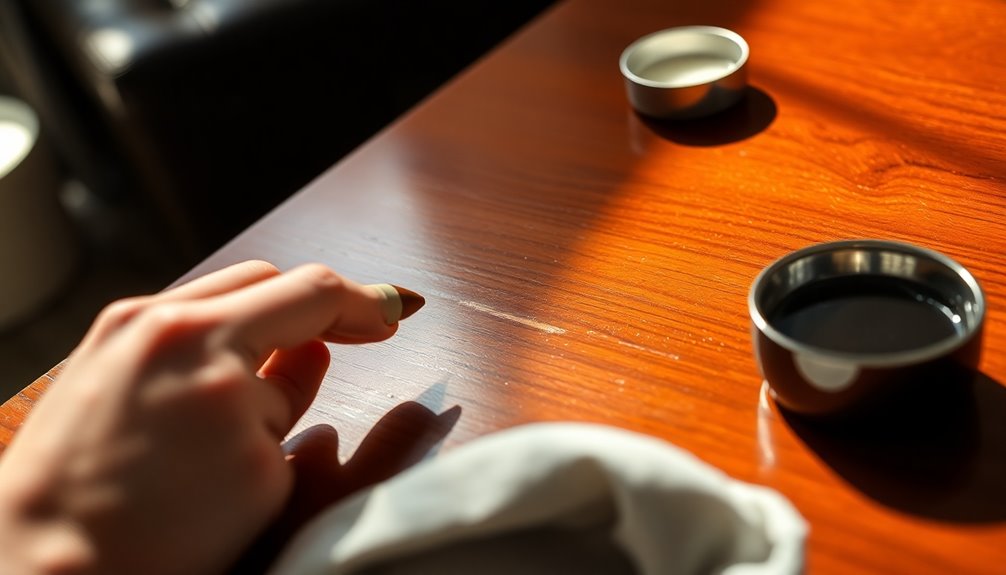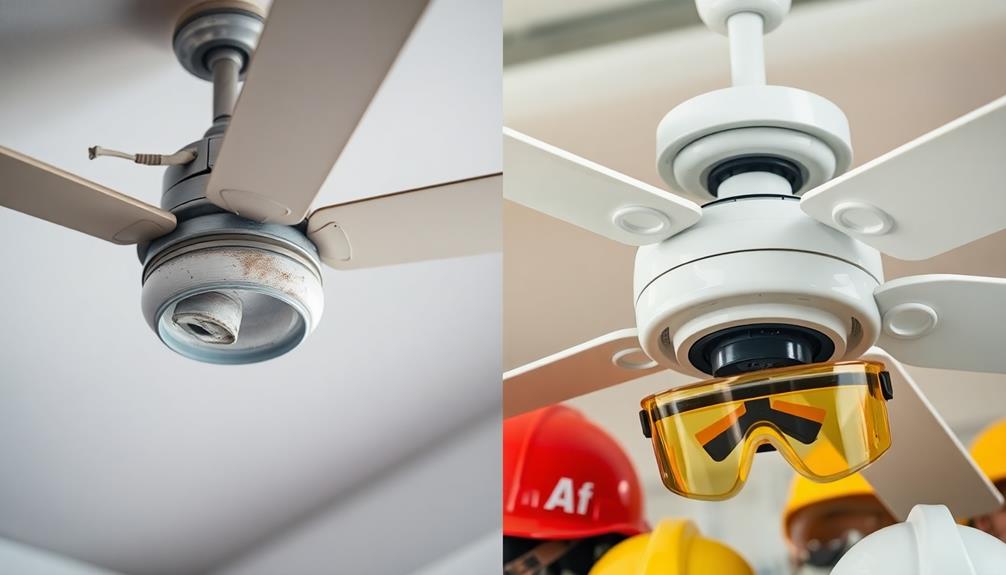You can easily fix scratches on your wood furniture with a few simple techniques. Start by assessing the damage; shallow scratches can be polished while deeper ones might need filler. Try using cooking oil or a mixture of vinegar and oil to darken and blend in the scratches. For deeper repairs, clean the area, apply a matching wood filler, let it dry, and then sand it smooth. If needed, consider using shoe polish to match the color and buff it to a shine. There are many more tips and tricks to keep your furniture looking great, so stick around to learn more!
Key Takeaways
- Assess the scratch's depth; use wood filler for deep scratches and household products for shallow ones.
- Clean the scratched area with a damp cloth before applying any repair products.
- For minor scratches, apply cooking oil or a mixture of vinegar and oil to blend the scratch.
- Sand the area gently with fine-grit sandpaper after filling to ensure a smooth finish.
- Consider professional help for multiple or deep scratches, especially on valuable furniture.
Assessing the Damage
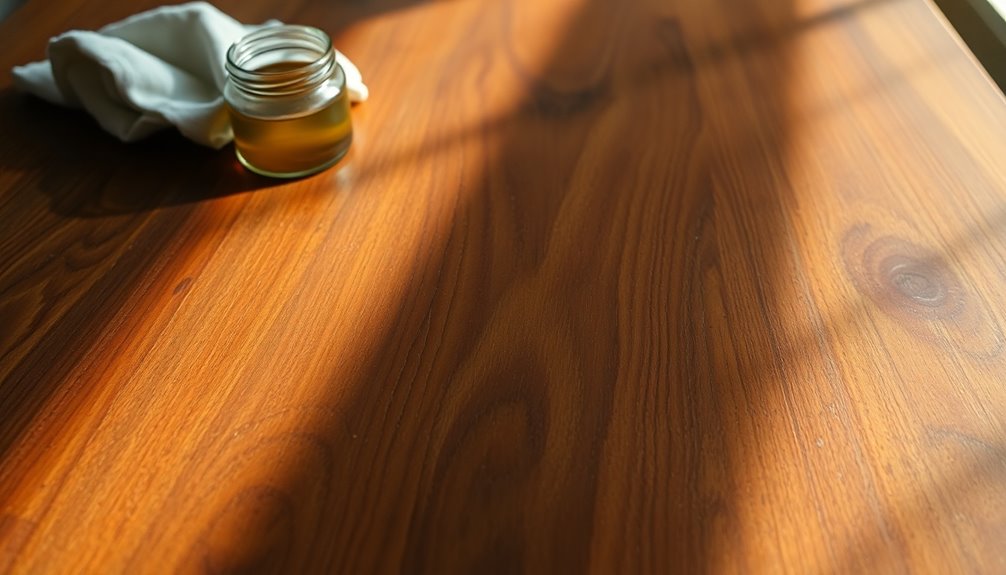
When you notice a scratch on your wood furniture, the first step is to assess the damage effectively. Start by determining if the scratch is shallow or deep. Shallow scratches typically only affect the finish, while deep scratches go beyond the surface, making it impossible to feel the bottom with your fingernail. If the scratch exposes the wood grain, you'll need to consider a more thorough repair.
Next, evaluate the severity of the scratch. Check if it has jagged edges that require smoothing with sandpaper. If the scratch has broken the surface but isn't deep enough for fillers, that's another factor to note. Multiple scratches might mean you'll need to sand and refinish the entire piece. Don't overlook any underlying damage that could compromise the furniture's structural integrity. Timely repair is crucial to prevent further damage that can worsen over time.
Prepare the surface by cleaning it with a damp microfiber cloth to remove dust and debris. This step can raise the grain, so keep that in mind. Make sure the area is free of obstructions and dry before you start your assessment. This careful evaluation will guide you in choosing the right repair method for your wood furniture. Once the surface is prepared, inspect the wood closely for any cracks or damage. If you notice any imperfections, it’s essential to assess their depth and severity, as this will help determine how to repair cracked wood effectively. By understanding the specific issues at hand, you can select the most appropriate products and techniques to restore your furniture to its former glory.
Using Household Products
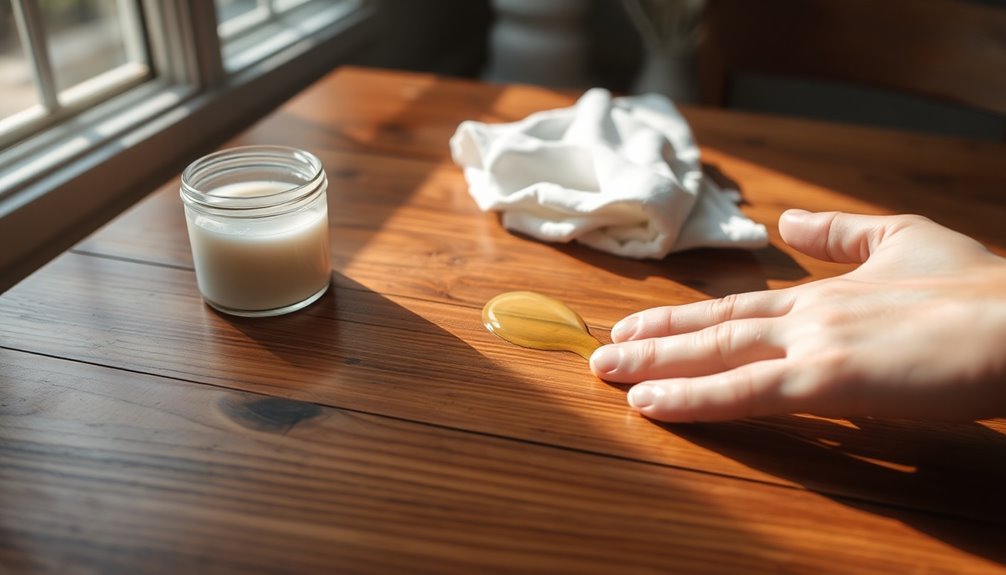
While it might seem daunting to tackle scratches on your wood furniture, using common household products can simplify the process. You can start with cooking oils like vegetable or canola oil. Just apply a small amount to your fingertips and rub it over the scratches. The oil darkens the area, helping it blend in with the surrounding wood. Canola oil is a budget-friendly choice, and olive oil works too.
For a more effective solution, mix 1/4 parts white vinegar with 3/4 parts oil. Shake it in a jar and use a soft cloth to apply the mixture to the scratches. This not only helps fill in scratches but also gives the wood a nice polish. Always test it on a hidden area first. Maintaining the appearance of wood furniture is essential for ensuring its longevity.
You could also use food items. Peanut butter can fill in scratches—just let it sit for about an hour before buffing. For darker woods, instant coffee mixed with hot water creates a paste that can stain scratches effectively. Lastly, apply a few drops of water to small dents and let them sit. If needed, use a warm iron with a damp cloth to raise deeper dents.
Using Shoe Polish
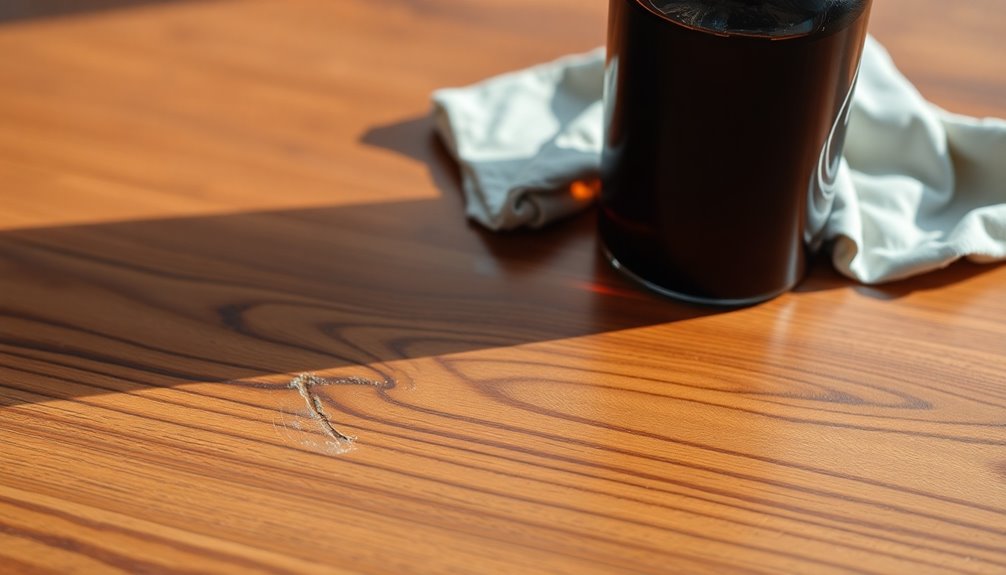
Shoe polish can be an effective and quick solution for disguising scratches on wood furniture. Start by preparing the area: clean the surface with a cloth and warm water, ensuring it's free of dirt. Once it's dry, test the shoe polish on a hidden spot, like the back leg of a desk, to check the color and reaction.
Next, select a shoe polish that matches your furniture's color. If you can't find an exact match, mix different shades on a paper plate until you achieve the right hue. Again, test this mixture in an inconspicuous area to confirm it blends well. Matching shoe polish color to your wood furniture is essential for effective results.
When you're ready to apply, take a small amount of polish on a paper towel or soft cloth, wrapping it around your finger for precision. Gently rub the polish into the scratch, avoiding the surrounding wood. Add more polish as needed until the scratch is less visible. For extra precision, a Q-tip works wonders.
Finally, wipe off any excess polish immediately to prevent staining, then buff the area with a clean cloth to restore shine. This method can effectively conceal scratches, but remember to avoid applying polish to undamaged areas.
Sanding and Smoothing
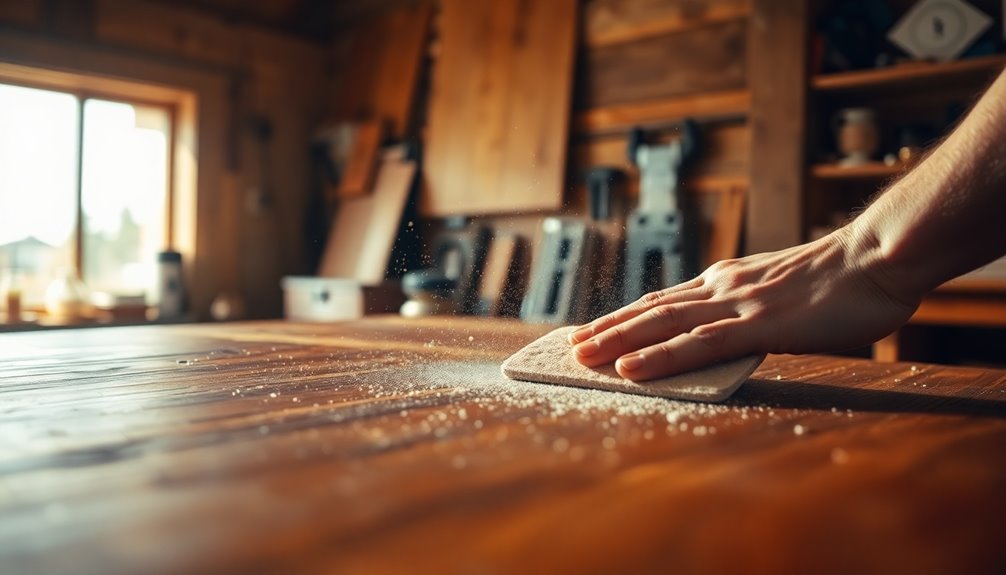
To effectively address scratches on wood furniture, sanding and smoothing is a reliable method that can restore the surface's appearance. Begin by using a sanding block to ensure even pressure. Always sand in the direction of the wood grain to avoid causing permanent scratches. For larger imperfections, start with coarse-grit sandpaper, like 80 or 120 grit. Gradually switch to finer grits, such as 180 or 240 grit, to achieve a smoother finish.
Be careful not to press too hard, as this can gouge the wood. Use lower grit sandpaper for deeper scratches and coarser surfaces, then transition to higher grit to blend and minimize imperfections. Don't skip grits; using each one in order is essential for a polished result. For soft woods, begin with a higher grit to prevent damage.
After sanding, thoroughly clean the area to remove dust and debris. Wipe away excess material with a clean cotton rag to smooth the surface. Finally, apply appropriate oil or wax to protect the wood and enhance the finish, as this can help prevent future water stains and buff with a soft cloth to restore shine and blend the repaired area.
Filling Deep Scratches
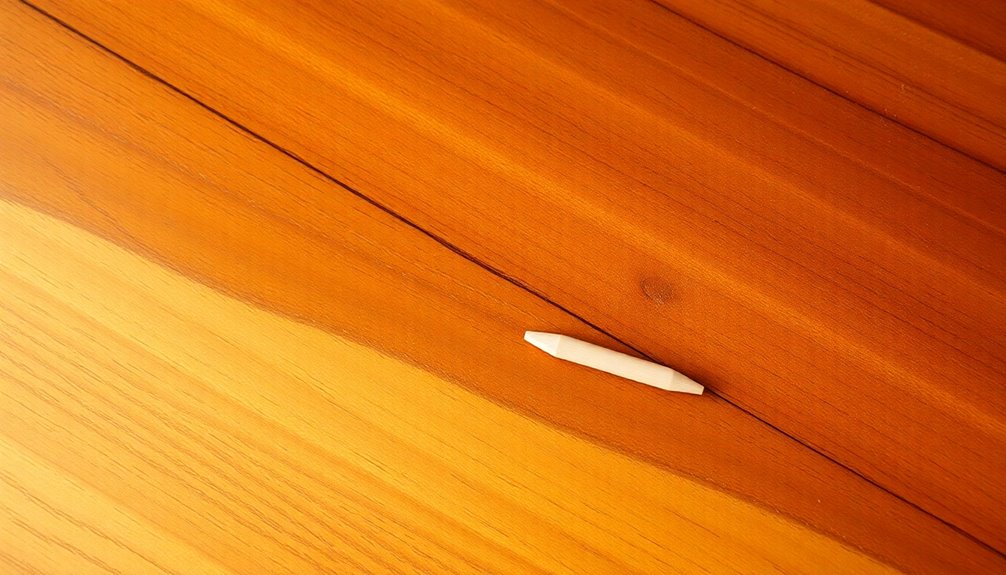
Filling deep scratches on wood furniture can seem daunting, but with the right approach, you can bring your piece back to life. Start by cleaning the area around the scratch with a damp microfiber cloth to remove dirt and debris. Use the corner of a putty knife to eliminate any loose residue from the scratch, ensuring the surface is completely dry before moving on.
Next, inspect the scratch to determine its depth and choose an appropriate wood filler that closely matches the furniture's color. For medium to deep scratches, wood filler sticks or wax crayons work well. Apply the filler using a putty knife, old credit card, or your fingers, ensuring there are no air gaps. Fill the scratch completely, adding more if needed for deeper gouges, and smooth the surface with the flat end of a palette knife. It's essential to start with initial cleaning to avoid contamination in the repair process.
Allow the filler to dry according to the manufacturer's instructions, which can take anywhere from 30 minutes to 8 hours. Once dry, sand the filled area gently with fine-grit sandpaper, following the wood grain, and remove any excess with a damp cloth. Repeat if necessary to achieve a smooth finish.
Refinishing and Sealing
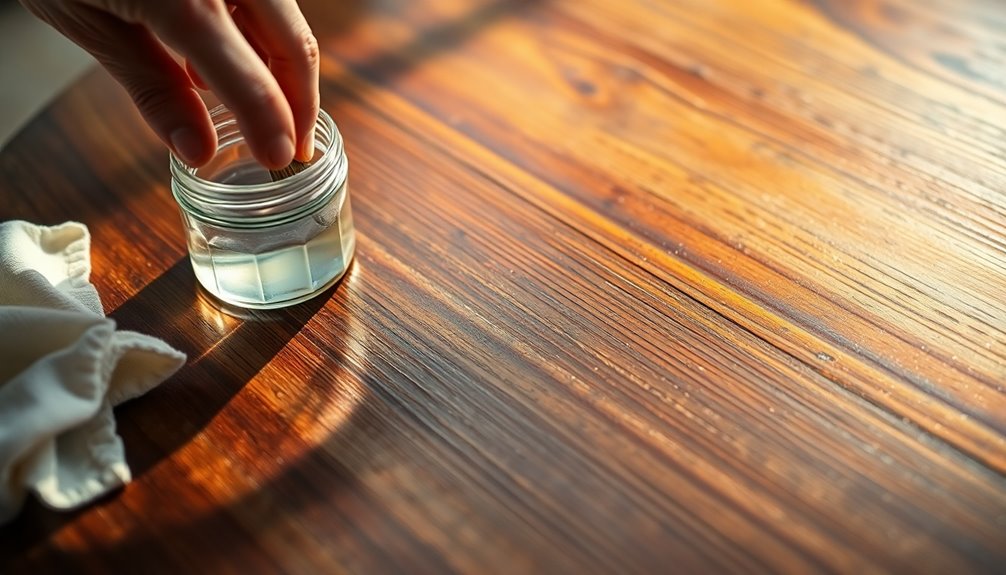
Refinishing and sealing your wood furniture can dramatically enhance its appearance and longevity. Start by thoroughly cleaning the piece to remove dirt, grime, and old wax. Next, assess the current state of the wood to determine the right refinishing method based on the type of wood and existing finish. To remove the old finish, use chemical strippers or sandpaper, beginning with coarse grit and progressing to finer grits.
When sanding, use long, even strokes along the grain to ensure a smooth surface. Incorporating textured fabrics during the refinishing process can further elevate the piece's overall aesthetic. After sanding, wipe down the area with mineral spirits to eliminate dust and contaminants. Once you achieve a smooth surface, choose a stain that matches the original color of the wood. Apply the stain according to the manufacturer's instructions, allowing it to dry properly.
To seal the repair, select a clear wood finish like polyurethane or lacquer. Applying a protective finish is critical for maintaining the integrity of your wood furniture. Apply the sealer evenly over the repaired area and let it dry as per the instructions. Finally, buff the sealed area with a soft cloth to restore shine and inspect for consistency, applying additional coats if necessary. This process will leave your wood furniture looking refreshed and protected.
Tips for Preventive Care
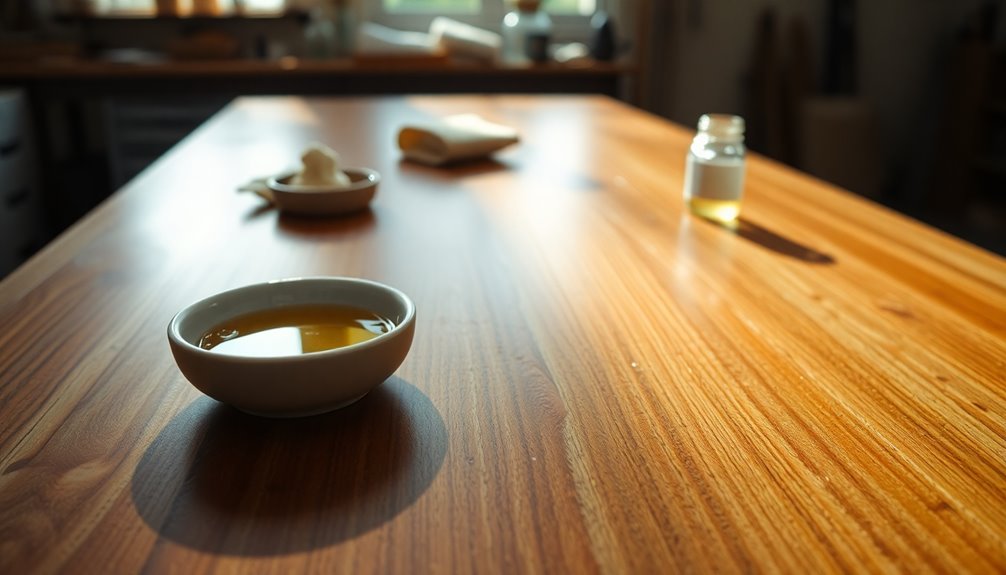
Caring for your wood furniture can make a world of difference in preserving its beauty and durability. Start by applying felt pads to the bottom of chair and table legs to cushion their contact with the wood. For heavier pieces, use flexible plastic floor protectors. Remember to replace these pads at the first sign of wear. Place rugs under feeding areas to catch spills and protect the wood from damage.
When it comes to pets and children, trim your pets' nails to prevent scratches, and supervise them closely to avoid accidents. Train your pets and establish ground rules for children to minimize risks.
Regular cleaning is crucial, too. Dust your furniture regularly with soft-bristled brushes or microfiber cloths to eliminate abrasive particles. Wipe up spills immediately to prevent moisture damage. Use coasters and mats to protect surfaces from cups and dishes. Additionally, consider using barrier protection methods to safeguard high-traffic areas from potential scratches.
Lastly, be cautious with sharp objects around your wood furniture. Designate trays for items like keys and scissors, and handle your furniture gently during moves. By following these tips, you'll keep your wood furniture looking great for years to come.
Best Practices for Maintenance
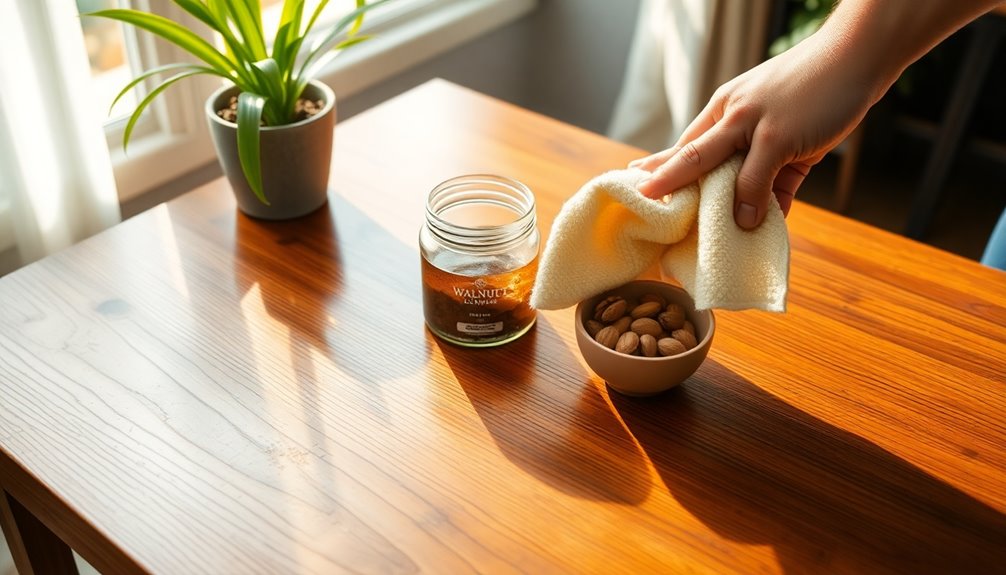
To keep your wood furniture in top shape, establish a regular maintenance routine that addresses cleaning, protection, and handling. Start by dusting your furniture frequently to remove abrasive particles that can scratch the surface. Use a gentle wood cleaner or a mild soap-and-water mixture for cleaning, and always wipe up spills immediately to prevent moisture damage. Avoid harsh chemicals and abrasive cleaners, and finish with a soft, dry cloth.
To protect your furniture, apply a quality furniture wax or polish, following the product's instructions for application. Consider using a clear wood finish like polyurethane to create a durable barrier. Regularly inspect this finish and reapply as needed. Use felt pads under objects to prevent scratches. Additionally, you can use natural remedies like the walnut method to help conceal and fill minor scratches.
When handling your furniture, lift items instead of dragging them across the surface. Coasters and placemats are essential for protecting against water marks and spills. Maintain a stable environment to prevent wood from warping, and avoid placing hot items directly on surfaces. Lastly, keep pets' nails trimmed and train them to steer clear of your wood furniture to minimize scratches.
When to Seek Professional Help
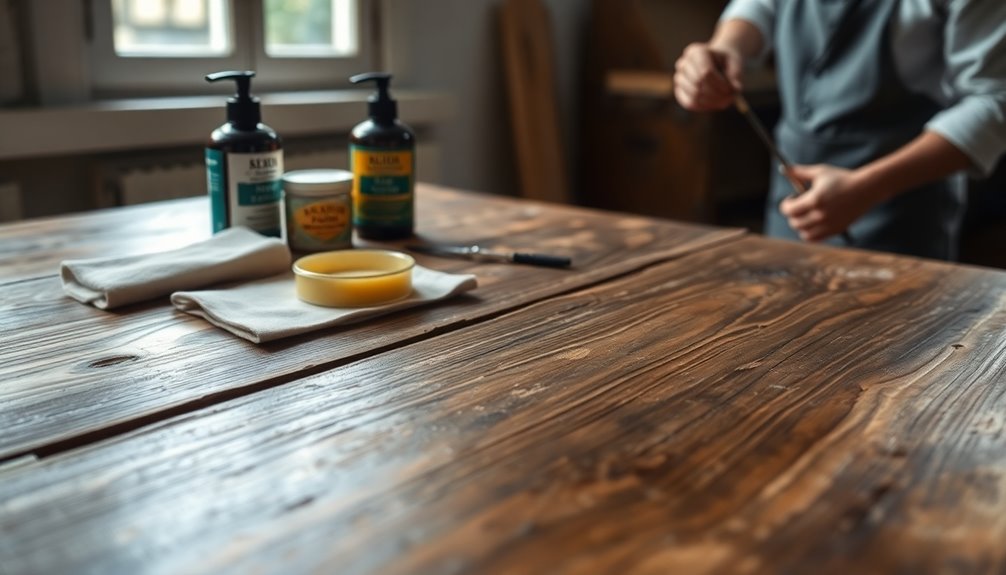
Even with diligent maintenance, there are times when scratches on wood furniture require professional intervention. If you notice multiple or deep scratches that penetrate through the clear coat, or if the damage covers a large area, it's best to seek expert help. Deep gouges or significant wood loss, especially if they expose the wood beneath, often need refinishing that's beyond DIY capabilities.
For valuable antiques, family heirlooms, or high-end furniture, hiring a professional is essential. These items often carry historical or sentimental value, and their intricate designs may require specialized skills and tools. If you're unsure about the type of finish or wood used, or if matching colors seems daunting, it's time to call in a pro. Addressing scratches promptly is crucial to maintaining the aesthetic appeal of your furniture.
Consider your time and convenience, too. If you lack the inclination or schedule to perform repairs yourself, a professional can quickly restore your furniture's appearance. They provide guaranteed high-quality results without the risk of further damage. In-home services can offer both efficiency and peace of mind, ensuring your cherished pieces receive the expert care they deserve.
Frequently Asked Questions
Can I Use Vinegar on All Wood Finishes?
You can't use vinegar on all wood finishes. Its acidic nature can damage many surfaces, stripping away protective coatings like varnish or lacquer, which leads to discoloration and deterioration. If you're considering using vinegar, always test it on an inconspicuous area first. For delicate finishes, it's best to avoid vinegar altogether and opt for safer cleaning methods to preserve the integrity and appearance of your wood furniture.
How Often Should I Polish My Wood Furniture?
You should polish your wood furniture based on how often you use it. For high-traffic pieces, aim to polish every six weeks, while less-used items might only need it every six months. Always keep an eye on the shine when buffing; if it isn't shining anymore, it's time to reapply. Regular dusting and occasional deep cleaning will help maintain its appearance and prolong the life of the finish.
Is It Safe to Use Water on Wood Furniture?
You should be cautious when using water on wood furniture. While a damp microfiber cloth can clean effectively, too much moisture can cause warping, swelling, and even mold growth. It's best to avoid excessive water exposure and always wipe the surface dry afterward. If you're looking for alternatives, consider using vinegar mixed with water or a wood polish, which can maintain your furniture's shine without the risks associated with water.
What Are the Best Tools for Repairing Scratches?
When you're tackling scratches, having the right tools makes all the difference. You'll want clean rags to dust off the area, scratch removers that match your wood's color, and fine sandpaper for smoothing. For deeper scratches, consider stain repair pens and a putty knife to fill and smooth any gouges. Don't forget a light layer of finish to protect your work. With these tools, you'll restore your wood beautifully!
Can Scratches Affect the Value of My Furniture?
Yes, scratches can definitely affect the value of your furniture. Minor scratches might lead to a small decrease, but deeper damage can significantly lower its worth. The quality of repairs plays a crucial role in this process; poor repairs may worsen the value loss. To understand the exact impact, it's wise to consult a qualified appraiser who can evaluate your furniture before and after any repairs are made.
Conclusion
Fixing scratches on wood furniture isn't just about aesthetics; it's about preserving the beauty of your pieces. By assessing the damage and using simple household products or polishing techniques, you can often restore their original charm. For deeper scratches, sanding and refinishing might be necessary. Remember to take preventive measures to protect your furniture in the future. If you ever feel overwhelmed, don't hesitate to seek professional help. Your furniture deserves the best care!
